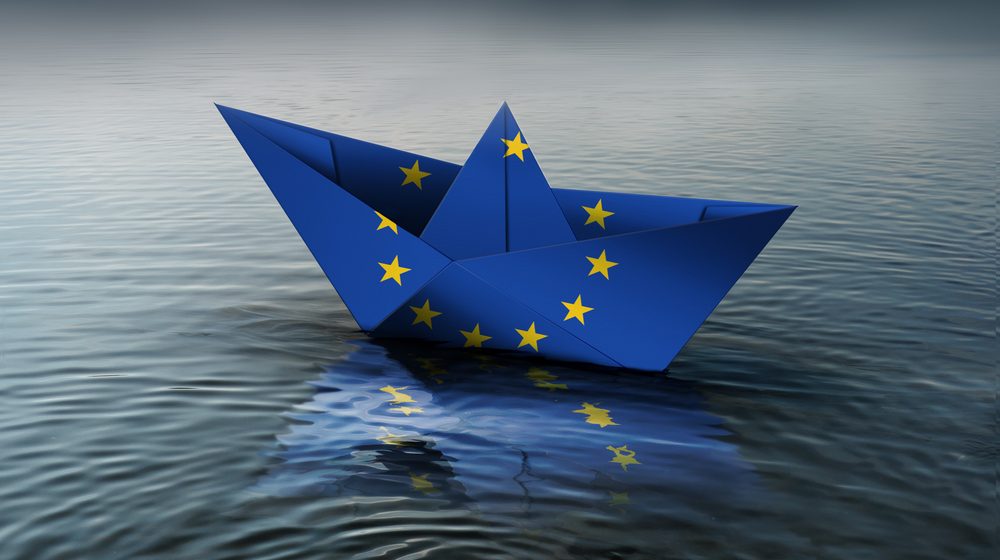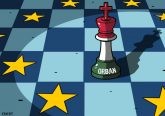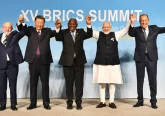What does the future of the European Union (EU) look like? Walking along the Rue de la Loi in the European Quarter in Brussels, the white and blue mural stating “The Future is Europe” by graffiti artist NovaDead sends a clear message. The bird in the right-hand corner stands for freedom and peace (referring to the values in Art. 2 of the Treaty on EU), the blue and yellow colours refer to the European flag, and the leaves recall the “green jungle” (a small forest of philodendrons) at the European Parliament in Strasbourg, which could also reflect the complex governance structure of the EU. But beyond this artistic and symbolic vision, what might the future of the EU look like in a practical sense?
In his book “Defekte Visionen. Eine Intervention zur Zukunft der Europäischen Union“ (Broken Visions. An Intervention on the Future of the European Union) Alexander Thiele, Professor of State Theory and Public Law at the BSP Business and Law School in Berlin, analyses five well-known reform proposals for the future of the EU in terms of their relevance and feasibility and addresses specific legitimacy deficits in each case, namely the “Humboldt Speech” by former German Foreign Minister Joschka Fischer, French President Emmanuel Macron’s 2017 speech on changes in a post-Brexit EU, the “Europe for Future” proposal by German political activists Vincent-Immanuel Herr and Martin Speer, the recent reform proposals of the “Conference on the Future of Europe”, and finally the so-called “Prague Speech” by German Chancellor Olaf Scholz at Charles University in August 2022.
In particular, Thiele argues that the visions of the future of the EU, mostly proposed by prominent actors, lack practicality and a clear rationale and normative framework, which he attributes to the dominance of (neo)-functionalism (“the Monnet method”) as an approach to integration since the failure of the European Political Community (EPC) in the 1950s. Instead of using functionalist ideas and referring to the EU as a technocratic “Rechtsgemeinschaft” (legal community), a term coined by the first President of the Commission of the European Economic Community Walter Hallstein (1901 – 1982), Thiele suggests that the question of European finality can only be answered if the EU is publicly seen as a political organisation in which politics must become effective: „The European Union remains a community of law – however a political community of law” (p. 26).
Indeed, the EU is a highly political project, given the expanding role of the European Commission as a “geopolitical commission”, which its President Ursula von der Leyen has been promoting since 2019. This is especially evident in external relations, e.g. in competition law (see, for instance, the Foreign Subsidies Regulation aimed at tackling foreign subsidies in the Single Market) or the Eastern Partnership (EaP) framework of the EU’s European Neighbourhood Policy (ENP). The increasing number of free trade agreements (FTAs) concluded between the EU and third countries could also be an indicator. The political nature of the European project was also underlined by the Empty Chair Crisis in 1965-1966 concerning the Common Agricultural Policy (CAP), when not a single Council decision could be adopted. From a theoretical point of view, it is worth noting that after the Empty Chair Crisis, Ernst B. Haas, who mostly developed the theory of neofunctionalism with Leon Lindberg and Philippe Schmitter, declared it “obsolete” (Haas 1976). However, neofunctionalism made a comeback in the mid-1980s and remains one of the main integration theories.
When discussing different integration theories like neofunctionalism and the functionality of the EU, a question is key: How actually can the governance structure of the EU be described? What is the EU? While the literature tends to treat the EU as a “sui generis” phenomenon – one could argue that this is a blurry definition that lacks any clarity and puts the EU in a black box – Thiele makes an interesting contribution. Interestingly, his book begins with a description of the governance structure of the Holy Roman Empire, a confederation of small and medium-sized political entities, that was neither a nation state nor a clear federation of states and therefore, like the EU, defies a clear categorical definition. In this context, Thiele speaks of a “monstrous European Union” (p. 13), a term which recalls the words of Jacques Delors (1925 – 2023), President of the European Commission from 1985 to 1995, who described the governance structure of the European project as “un objet politique non identifié” (an unidentified political object). However, according to the author, this lack of definition and “ambiguity in terms of state theory (and the associated conceptualisation) […], is not problematic per se” (p. 14). Rather, the functionality of the structures of the EU is more important than the definition itself. Nevertheless, as Thiele points out throughout the book, the functioning of the EU can be questioned in light of several recent crises, Brexit, and the failed Constitutional Treaty in 2005, which leads to the normative question of how the EU should function and look like. Moreover, Thiele argues that it remains unclear which specific integration problems are addressed by the different proposed visions, and that actors fail to contribute to improving the functioning of the EU’s complex governance structure. As a result, the proposed visions, while insightful and stimulating, are merely “broken visions” (p. 28).
With his publication, Thiele provides a fruitful and persuasive analysis of the debate on (institutional) reforms of the EU. He stresses that most of the proposed visions for the future of the EU fail to provide sufficient and workable guidance. He argues that Joschka Fischer’s speech did not focus on specific integration issues and also lacked a normative framework. Emmanuel Macron’s Sorbonne speech, which referred to European sovereignty – a nebulous concept – did not explain why he was proposing specific changes. Similarly, the “Europe for Future” proposal by Vincent-Immanuel Herr and Martin Speer, which presents 95 theses, is insufficient, despite some innovative ideas. A common framework is missing, and the authors give little thought to the role of the member states. Similarly, the “Conference on the Future of the European Union”, initiated by Emmanuel Macron in 2019, which led to 49 proposals presented on 9th May 2022, does not really propose any institutional changes, despite changing some names of EU institutions. Therefore, according to Thiele, the report presented “remains vague in terms of content and does not answer the question of transformation” (p. 55). Lastly, the “Prague Speech” of German Chancellor Olaf Scholz held at Charles University in August 2022 – which addressed geopolitical challenges in light of Russia’s war of aggression against Ukraine and emphasised the need for a “geopolitical Europe”, and proposed further steps towards EU enlargement and institutional reform – lacked a concrete framework. Nor is it clear “which tasks a reformed EU should fulfil in cooperation with the member states in the future” (p. 60).
Despite the nuanced analysis of the five reform proposals, the case selection of discussed speeches and proposals on the future of the EU could have been made clearer, especially as they mostly reflect Franco-German positions. It remains unclear to the reader why these cases in particular were chosen. It would have been more insightful to learn about other proposals that are less well known. In the author’s defence, however, he argues that the “randomly selected” proposals (p. 28) reflect the general shortcomings of the current debate on the finality of the EU.
In the second part of the book, Thiele refers to the values in Art. 2 of the Treaty on EU and argues that abstract criteria of legitimacy can be derived from the goal of a democratic system based on the rule of law, which is also expressed in the preamble. Therefore, he presents criteria, for good governance, in particular participation rights, limitation, and control of power, and sufficient efficiency of power, which should be used as normative framework to maximise the EU’s legitimacy (pp. 61 – 82). Finally, the last part of the book deals with the legitimacy of the EU, for instance how a common media landscape at the European level could reduce the democratic deficit or how changing and restructuring the competences of the EU could enhance legitimacy (“More Europe through less Europe”, p. 108). Instead of a fundamental reform, Thiele convincingly proposes to focus on gradual reforms, which should aim at eliminating specific legitimacy deficits by achieving and maximising a “Verbundlegitimität”, a common legitimacy between the EU and its member states. The problems and possible solutions that Thiele discusses (e.g. improving individual legal protection, reducing the number of commissioners) – while not entirely new to the debate – provide a comprehensive summary and analysis of key developments and legitimacy problems that can be used as a starting point for future debate.
In conclusion, Thiele’s book highlights an urgent matter, the question on the future of the EU. In around 100 pages, he provides an insightful and compact analysis, covering a wide range of aspects – from the EU’s governance structure to its democratic deficit and issues of legitimacy. The upcoming European Parliament elections in June 2024, and a new European Commission, could be a turning point for a new vision on the EU’s future. However, Europe does not need more repetitive speeches with vague and nebulous visions and concepts; Europe does not need more “old wine in new bottles”. Political actors and leaders need to prove that the statement “the Future is Europe” on the mural in the European Quarter is built on solid ground and remains resilient – we need a concrete vision that explains the how and the why, a vision for the future of the EU that works.
Note: Broken Visions: An Intervention on the Future of the European Union was published in German. The title and quotes have been loosely translated into English.
This article reflects the views of the author and not the position of the DPIR or the University of Oxford.







